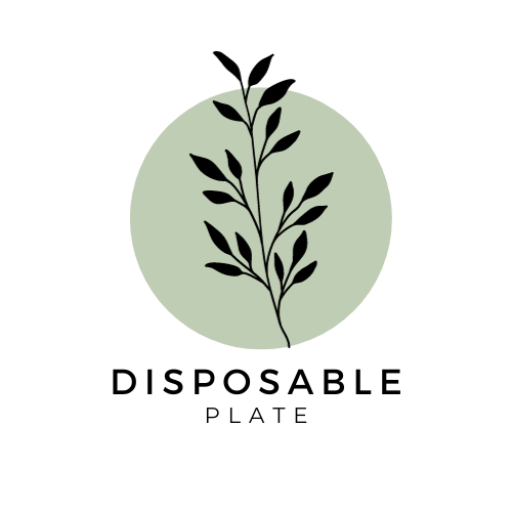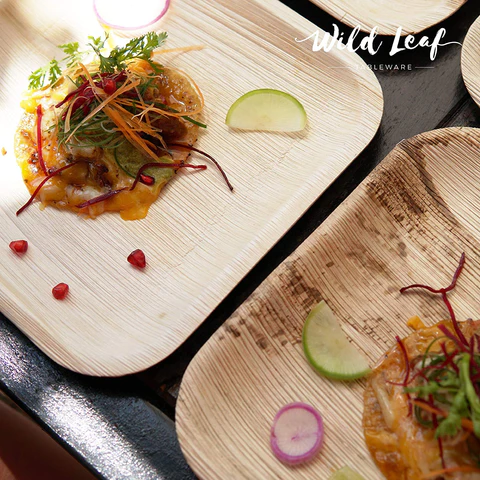In today’s world, where sustainability has become more than just a buzzword, the dining industry is seeing a significant shift towards eco-friendly practices. Among the champions of this movement are palm leaf plates, a premium, sustainable alternative to traditional dining ware. This article delves into why palm leaf plates are not just a choice but a statement of luxury and responsibility.
Table of Contents
Why Choose Palm Leaf Plates?
- Eco-Friendliness: Palm leaf plates are made from the naturally fallen leaves of the Areca palm tree, ensuring that no trees are cut down in their production. This sustainable sourcing method significantly reduces the environmental impact compared to traditional disposable plates made from plastic or paper, which require more energy and resources to produce and can take hundreds of years to decompose.
- Biodegradability and Compostability: Unlike plastic tableware, palm leaf plates are 100% biodegradable and compostable. They break down naturally within a few months when composted, turning into nutrient-rich soil without leaving any harmful residues. This makes them a perfect choice for reducing landfill waste and promoting a healthier environment.
- Durability and Functionality: Despite their natural origins, palm leaf plates are remarkably durable. They are designed to withstand hot, cold, and even liquid foods without bending, breaking, or leaking. This strength ensures they are not just environmentally friendly but also highly functional for a variety of dining occasions.
- Unique Aesthetic Appeal: Each palm leaf plate has a distinct pattern, texture, and color, reflecting the natural beauty of the leaf it was made from. This uniqueness adds an elegant and rustic charm to your table setting, making each dining experience special. Whether it’s a formal event, a casual gathering, or everyday home use, these plates enhance the presentation of your meals.
- Chemical-Free Production: The process of making palm leaf plates involves no chemicals or synthetic additives. The leaves are simply cleaned, dried, and heat-pressed into shape. This natural production method ensures the plates are safe for all, including children and those with chemical sensitivities, offering peace of mind for health-conscious consumers.
- Versatility: Palm leaf plates are suitable for a wide range of occasions, from weddings and corporate events to picnics and family dinners. Their natural elegance suits various decor themes, from rustic to tropical to minimalist, providing a versatile option for event planners and homeowners alike.
- Supports Local Economies: The production of palm leaf plates often supports local communities where Areca palm trees grow. By providing an additional source of income for farmers through the collection of fallen leaves, this industry helps sustain rural economies and encourages sustainable agricultural practices.
- Cost-Effective: While offering all these benefits, palm leaf plates are also cost-effective, especially when considering their environmental and aesthetic advantages. They provide a high-value alternative to traditional disposable plates, offering better quality and sustainability at a competitive price.
The Manufacturing Process
- Collection of Palm Leaves: The first step involves gathering the fallen leaves of the Areca palm tree. This collection process ensures that no trees are cut down, preserving the natural ecosystem. The leaves are typically collected by local farmers, providing them with an additional source of income and encouraging sustainable agricultural practices.
- Cleaning: Once collected, the leaves undergo a thorough cleaning process. They are washed to remove any dirt and debris, ensuring that they are completely clean and sanitary before being transformed into plates. This step is crucial for maintaining the high quality and safety standards of the final product.
- Drying: After washing, the leaves are left to air dry naturally. This drying process is essential for removing any moisture that could compromise the integrity of the plate during shaping. The use of natural sunlight for drying further underscores the eco-friendly approach of the entire manufacturing process.
- Pressing and Shaping: The dried leaves are then heat-pressed into various shapes and sizes using specially designed molds. This step does not involve any chemicals or glues, keeping the plates completely natural and biodegradable. The heat pressing also sterilizes the leaves, making them safe for food contact. The versatility of this process allows for a wide range of plate designs, catering to different dining needs and preferences.
- Trimming and Finishing: After pressing, the edges of the plates are trimmed to remove any irregularities, ensuring a smooth, even finish. This finishing touch not only enhances the aesthetic appeal of the plates but also makes them more practical for use, eliminating any sharp or rough edges.
- Quality Check: The final step in the manufacturing process is a thorough quality check. Each plate is inspected for defects such as cracks, splits, or uneven surfaces. Only the plates that meet strict quality standards proceed to packaging, ready to be shipped to consumers around the world.
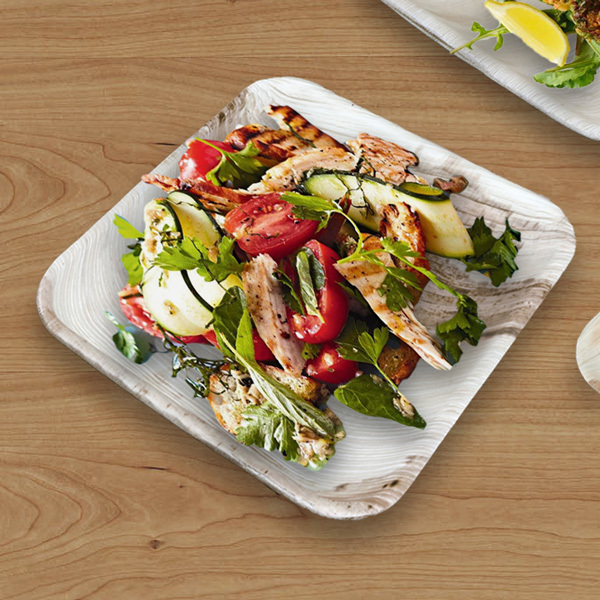
The Environmental Impact
- Reduction of Plastic Waste: Traditional disposable plates, often made from plastics, contribute significantly to global plastic pollution. Plastic takes hundreds of years to degrade and can release harmful chemicals into the environment as it breaks down. Palm leaf plates, on the other hand, are entirely natural and biodegradable, decomposing in a matter of months without leaving any toxic residues. This shift can drastically reduce the volume of waste in landfills and oceans.
- Sustainable Resource Use: The manufacturing of palm leaf plates utilizes fallen leaves from the Areca palm tree, which means no trees are cut down in the process. This sustainable sourcing contrasts sharply with the resource-intensive production of paper plates, which often involves deforestation and significant water and energy consumption. Palm leaf plates make efficient use of a naturally renewable resource without harming the ecosystem.
- Carbon Footprint: The production and decomposition of palm leaf plates have a much lower carbon footprint compared to plastic or even paper alternatives. Since the process is primarily mechanical (cleaning, drying, and heat pressing), it requires minimal energy. Moreover, as the plates decompose naturally, they do not emit methane—a potent greenhouse gas often released by decomposing organic matter in oxygen-poor landfills.
- Composting and Soil Health: Palm leaf plates are not only biodegradable but also compostable. When composted, they return to the earth, enriching the soil with organic matter and promoting healthier plant growth. This contributes to a circular economy, where waste products are repurposed and reused, reducing the need for synthetic fertilizers and improving soil health over time.
- Encouraging Sustainable Practices: The rising popularity of palm leaf plates can also have a broader impact by encouraging individuals, businesses, and communities to adopt more sustainable practices. As demand for eco-friendly products grows, it can drive innovation in sustainable manufacturing, reduce reliance on single-use plastics, and raise awareness about the importance of environmental stewardship.
- Biodiversity Conservation: By promoting the use of naturally fallen leaves without the need to harm or cut down trees, the production of palm leaf plates supports the conservation of biodiversity. The Areca palm trees continue to grow and contribute to their natural habitat, supporting a healthy ecosystem and preserving biodiversity.
- Reducing Water Pollution: Unlike the production of plastic, which can release harmful chemicals into waterways, the manufacturing of palm leaf plates involves no toxic substances. This reduces the risk of water pollution, protecting aquatic life and ensuring cleaner rivers, lakes, and oceans.
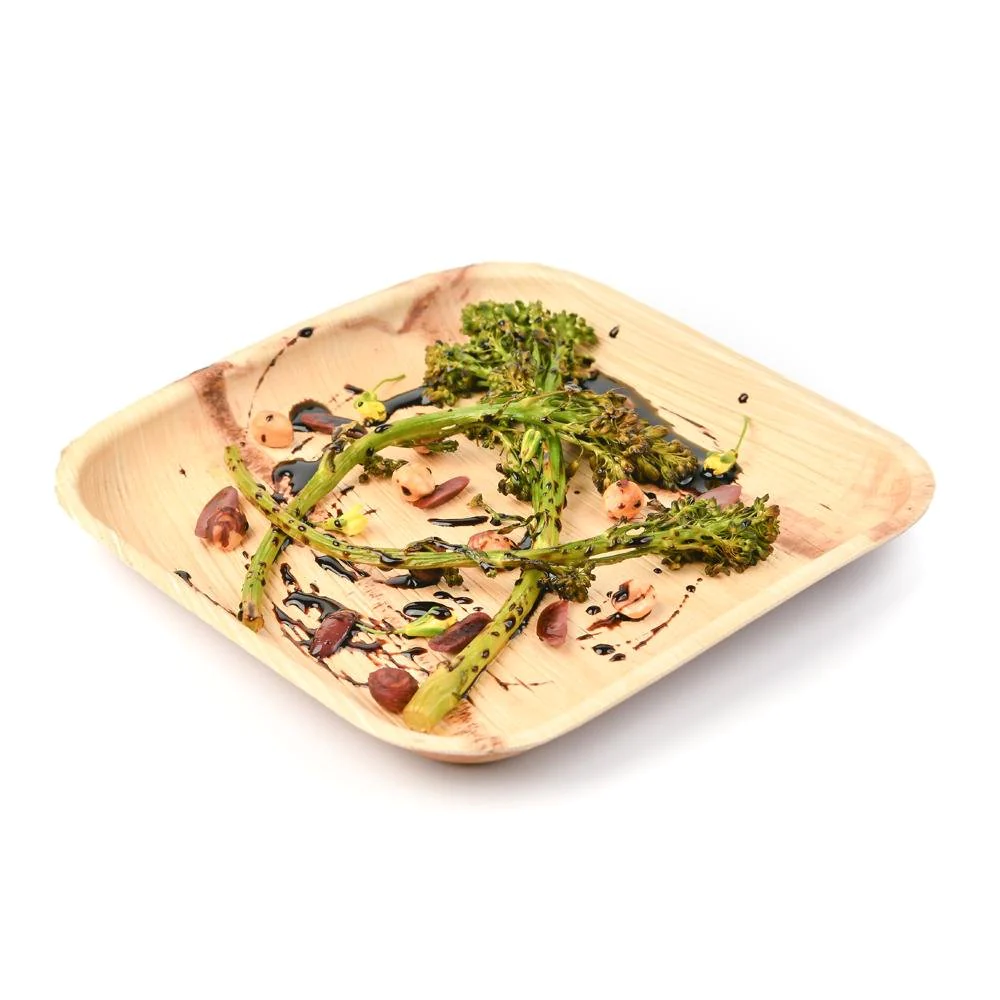
The Aesthetic Appeal
- Natural Elegance: Palm leaf plates exude a rustic yet sophisticated charm that can elevate the presentation of any meal. Their earthy tones and organic textures make them especially suitable for outdoor events, garden parties, and eco-themed weddings, where they harmonize beautifully with natural surroundings.
- Unique Design: Each plate is a piece of natural art, with its own unique patterns and hues. The variations in color, from light beige to rich browns, and the natural vein patterns of the leaf, add character and depth to table settings, making each dining experience unique.
- Versatility: Despite their natural, rustic look, palm leaf plates can adapt to a wide variety of dining environments, from casual to formal. They can complement a bohemian wedding, add a touch of warmth to a minimalist setting, or bring an organic feel to a modern event. Their versatility makes them a popular choice among event planners and home entertainers alike.
- Theme Integration: For those looking to create a cohesive and themed dining experience, palm leaf plates offer the perfect solution. They work well with themes that emphasize sustainability, nature, and simplicity, enhancing the thematic depth of the event or dining environment.
- Tactile Experience: Beyond their visual appeal, palm leaf plates offer a unique tactile experience. The texture of the leaf, smooth yet distinctly natural, adds an element of sensory engagement that typical tableware cannot provide. This tactile quality can make the dining experience more memorable and engaging for guests.
- Conversation Starters: The distinctiveness and eco-friendly nature of palm leaf plates often spark curiosity and conversation among guests, making them not just a part of the meal but an integral aspect of the dining experience. They offer an opportunity to discuss sustainability and the importance of eco-conscious choices in everyday life.
- Complementing Cuisine: The natural, organic look of palm leaf plates can also enhance the presentation of food, making them particularly suitable for dishes that emphasize fresh, wholesome ingredients. They add a visually appealing contrast to colorful fruits, vegetables, and gourmet dishes, making the food look even more inviting.
Versatility in Use
- Technology: In technology, versatility is a key attribute for devices and software. A versatile technology product, such as a smartphone or a multi-functional software platform, can perform multiple functions, replacing the need for multiple dedicated devices or software solutions. This not only saves resources but also enhances user convenience and efficiency.
- Business: In the business world, versatility refers to the adaptability and flexibility of companies and their employees. Versatile businesses can quickly adapt to market changes, diversify their product lines, and enter new markets. Similarly, employees who possess a versatile skill set are highly valued for their ability to perform a variety of tasks and adapt to different roles or challenges.
- Education: Versatility in education means providing learners with skills that can be applied in various contexts. An educational program that encourages versatility prepares students not only for specific careers but also equips them with critical thinking, problem-solving skills, and adaptability that are valuable in any field.
- Daily Life: In everyday life, versatility might refer to multi-functional tools, appliances, or even clothing that can be used in different settings or for various purposes. This can lead to cost savings, reduced environmental impact, and a simpler, more efficient lifestyle.
Complementing Your Decor
- Understand Color Theory: Use a color palette that complements the existing hues in your space. Consider the color wheel and choose colors that harmonize well together. You can opt for analogous colors (colors next to each other on the color wheel) for a harmonious look, or complementary colors (colors opposite each other on the color wheel) for more contrast and vibrancy.
- Incorporate Textures: Mixing different textures can add depth and interest to your space. Combine smooth and rough textures, such as pairing a sleek leather sofa with a fluffy throw pillow. This contrast in textures can enhance the tactile and visual appeal of your decor.
- Balance Proportion and Scale: The size of furniture and decor items relative to the room and each other is crucial. A large room can accommodate bigger or more pieces, while a small room benefits from fewer, more appropriately scaled items. Keep the proportion of your furnishings in mind to create a balanced and comfortable space.
- Add Accent Pieces: Accent pieces like artwork, rugs, throw pillows, and decorative objects can add pops of color, texture, and personality to your decor. Choose items that reflect your interests and personality, but also complement the existing color scheme and style of your space.
- Consider Lighting: Lighting plays a significant role in complementing your decor. Use a mix of ambient, task, and accent lighting to enhance the atmosphere of your space. Lighting fixtures themselves can also serve as decorative elements that complement your decor style.
- Mix Styles Thoughtfully: While maintaining a cohesive look, you can mix different decor styles for a more personalized and eclectic aesthetic. The key is to find a common element, such as color, material, or design period, that ties different styles together harmoniously.
- Leave Room for Negative Space: Avoid cluttering your space with too many items. Negative space, or the empty areas around and between objects, is important in design as it allows each piece to “breathe” and stand out more effectively.
- Reflect Your Personality: Ultimately, the best way to complement your decor is to make it personal. Incorporate elements that tell your story, whether it’s through family heirlooms, travel souvenirs, or artwork that you love. A space that reflects your personal style will always feel complementary and cohesive.
How to Dispose of Palm Leaf Plates
- Composting: The most environmentally friendly way to dispose of palm leaf plates is by composting them. Palm leaf plates are 100% biodegradable and will break down in a compost pile, turning into nutrient-rich soil over time. If you have a home compost system, simply break the plates into smaller pieces to speed up the decomposition process and add them to your compost bin. They are considered “brown” compost material and should be balanced with “green” materials like food scraps.
- Municipal Composting Facilities: If you don’t have a home composting setup, check if your local waste management system includes industrial or municipal composting facilities that accept biodegradable items like palm leaf plates. These facilities can handle larger volumes of compostable materials and often have the capability to compost items more efficiently than home composting systems.
- Garden Mulch: If the plates are not heavily soiled, you can also use them as a form of mulch for your garden. Break the plates into smaller pieces and spread them around your plants. Over time, they will decompose and contribute to the soil’s nutrient content while helping to retain moisture and suppress weeds.
- Landfill Disposal: If composting is not an option for you, disposing of palm leaf plates in the trash is still more environmentally friendly than using plastic or Styrofoam plates, as they will eventually biodegrade in a landfill. However, this process is significantly slower than composting due to the lack of oxygen and proper conditions for decomposition in most landfill environments.
- Avoid Burning: It might be tempting to consider burning palm leaf plates as a disposal method, especially if you’re looking for a quick way to reduce waste volume. However, burning can release pollutants and carbon dioxide into the atmosphere. It’s better for the environment to choose one of the above disposal methods.
How to Choose the Right Plates
Material: Plates come in various materials, each with its own benefits and drawbacks.
- Porcelain or China: Elegant and refined, perfect for formal occasions but can be used daily. They are durable, non-porous, and can often be microwave and dishwasher safe.
- Stoneware: Known for its sturdy and rustic appeal, stoneware is ideal for everyday use. It’s heavier than porcelain and can come in various finishes, but it may require more care to prevent chipping.
- Earthenware: Offers an earthy, organic look and is typically more affordable, but it’s less durable and more prone to chipping.
- Melamine: Lightweight and virtually unbreakable, making it perfect for outdoor dining or families with young children. However, it’s not suitable for microwave use.
- Glass: Can be clear or colored, offering a modern look. Glass plates are non-porous and easy to clean, but they can be heavy and prone to breaking.
- Bamboo or Palm Leaf: Eco-friendly options that are biodegradable and compostable, suitable for casual use or special eco-conscious events.
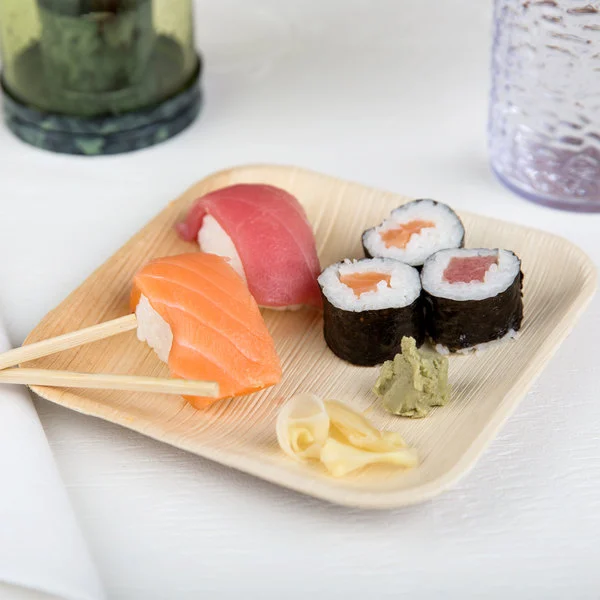
- Durability: Consider how often you’ll be using the plates and in what settings. For daily use, look for chip-resistant materials like high-fired porcelain or stoneware. If you entertain outdoors frequently, melamine or bamboo might be the best choice.
- Maintenance: Check if the plates are dishwasher and microwave safe. Some materials, like fine china or certain types of stoneware, might require hand washing or may not be microwave safe.
- Size and Shape: Think about your storage space and what you’ll be serving. Standard dinner plates are about 10 to 12 inches in diameter, but you may want options like salad plates, bread plates, or bowls. The shape (round, square, or oval) can influence how you present your meals and how the plates stack in your cabinets.
- Style and Design: Choose a design that reflects your personal style and complements your dining room or kitchen decor. Consider whether you prefer a timeless look that won’t go out of fashion or if you like to change things up regularly.
- Set or Individual Pieces: Decide if you want to buy a complete set of plates (which may include other pieces like bowls and cups) or prefer to purchase individual pieces. Buying a set can be more cost-effective, but selecting individual pieces allows for more customization and the ability to easily replace items.
- Price: Set a budget before you start shopping. The price of plates can vary widely based on material, brand, and design. Higher-quality materials and designer brands will cost more, but investing in durable plates can save money in the long run.
Size and Shape Considerations
Size Considerations
- Proportion to the Room: Items should be proportionate to the size of the room. Large furniture in a small room can make the space feel cramped, while small pieces in a large room might look lost or insufficient.
- Scale Relative to Other Items: The size of new items should be considered in relation to existing pieces. For instance, a large dining table requires chairs that are of appropriate scale to avoid an unbalanced look or discomfort.
- Functionality: Consider how the size of an item affects its use. For example, a bed should fit the room while providing enough space for comfortable movement around it. Similarly, a desk should be large enough for the tasks it will be used for.
- Storage and Accessibility: Ensure that items are of a size that allows for easy storage or includes storage capabilities, especially in smaller spaces. Also, consider whether the size might affect the ease of access to the item and its functionality.
- Passageways: Keep in mind the size of doors, stairways, and hallways when selecting large items to ensure they can be moved into the desired space.
Shape Considerations
- Aesthetics and Style: The shape of an item should complement the overall design style of the space. Geometric shapes might fit better in modern or minimalist designs, while organic shapes could enhance more natural or eclectic interiors.
- Space Efficiency: Some shapes utilize space more efficiently than others. For example, a round table might fit better in a small kitchen, while rectangular pieces might be more suitable for aligning against walls or in rectangular rooms.
- Flow and Movement: The shape of furniture and decor can influence the flow of movement within a space. Rounded corners might facilitate easier movement and a softer look, while sharp corners can create a more structured layout.
- Visual Balance: Consider how the shape of items contributes to the visual balance in a room. Mixing various shapes can add interest and dynamism, but there should be a sense of harmony in the overall composition.
- Emotional Impact: Shapes can evoke different feelings and atmospheres. Rounded shapes are often seen as softer and more welcoming, while angular shapes can convey formality and efficiency.
Buying Tips and Recommendations
1.Assess Your Needs
- Identify the Need: Clearly define why you need the item and what problem it will solve or need it will fulfill.
- Usage: Consider how often and in what context the item will be used. This will help determine the level of durability and quality you should look for.
2. Do Your Research
- Read Reviews: Look for reviews from other consumers who have purchased the item. Pay attention to both positive and negative feedback.
- Compare Products: Look at different brands and models to compare features, prices, and value. Use comparison sites if available.
- Check Ratings: Consumer reports and independent review sites can provide unbiased ratings on a wide range of products.
3. Set a Budget
- Price Range: Determine how much you are willing to spend. Remember, the most expensive option is not always the best.
- Hidden Costs: Be aware of any additional costs, such as shipping, installation, or accessories that might be needed.
4. Consider Quality vs. Price
- Long-Term Investment: Sometimes, spending a bit more on a higher-quality item can save money in the long run if it lasts longer or performs better.
- Warranties and Guarantees: Check if the item comes with a warranty or guarantee, which can provide peace of mind and save costs on potential repairs.
5. Evaluate Features and Specifications
- Essential Features: Identify which features are must-haves and which are nice-to-have but not necessary. This can help prevent paying for extras you won’t use.
- Specifications: For technical products, make sure the specifications match your requirements (such as size, capacity, or compatibility).
6. Consider the Environmental Impact
- Sustainability: Look for products made with sustainable materials or practices. Consider the environmental footprint of what you’re buying.
- Energy Efficiency: For appliances or electronics, energy efficiency not only reduces environmental impact but can also save money on utility bills.
7. Timing Your Purchase
- Sales and Promotions: Keep an eye out for sales, discounts, or promotional periods, which can offer significant savings.
- Off-Season Buying: Purchasing items off-season can often result in lower prices (e.g., buying winter gear in the summer).
8. Know the Return Policy
- Return Policy: Familiarize yourself with the return policy before purchasing. Ensure you can return or exchange the item if it doesn’t meet your expectations.
9. Shop from Reputable Sellers
- Reputation: Purchase from reputable sellers with good customer service records. This is especially important for online purchases.
- Authenticity: Ensure the product is genuine, particularly when buying brand-name goods, to avoid counterfeit items.
10. Safety and Security
- Product Safety: Check for any safety certifications or endorsements, especially for items like children’s toys, electronics, or appliances.
- Payment Security: When buying online, ensure the website is secure (look for HTTPS in the URL) and consider using payment methods that offer buyer protection.
Conclusion
Palm leaf plates represent the perfect marriage of sustainability, style, and practicality. By choosing these eco-friendly alternatives, you’re not just making a statement about your commitment to the environment but also bringing a piece of nature’s beauty to your dining experiences.
FAQs
- Are palm leaf plates safe for all types of food? Yes, they are safe for both hot and cold foods and do not impart any taste to the food.
- Can palm leaf plates be reused? While they are designed for single use, if they are not heavily soiled, they can be gently wiped clean and reused for light snacks.
- How long do palm leaf plates take to compost? They typically compost within 60 to 90 days in a proper composting facility.
- Are palm leaf plates more expensive than plastic plates? While they might be slightly more expensive upfront, their environmental benefits and unique aesthetic make them a valuable investment.
- Where can I buy palm leaf plates? Palm leaf plates are available from a variety of online retailers, eco-friendly stores, and specialty kitchenware shops.
